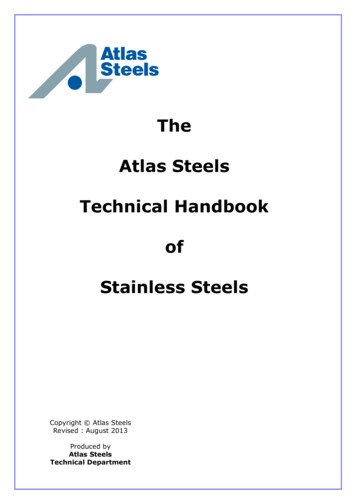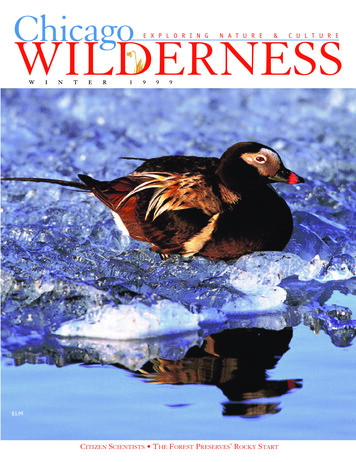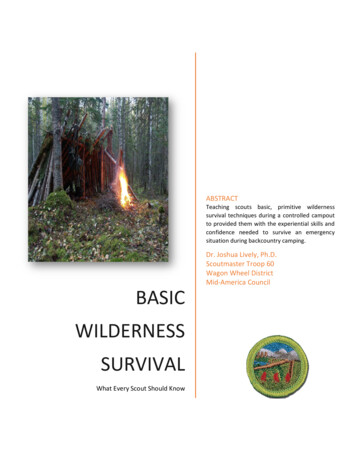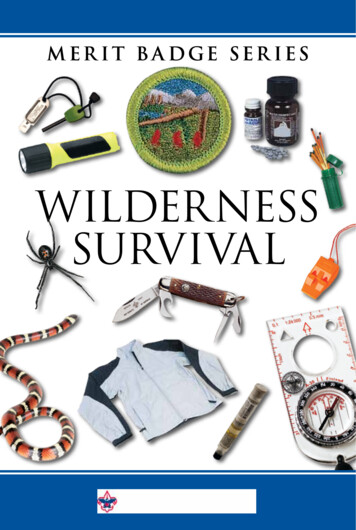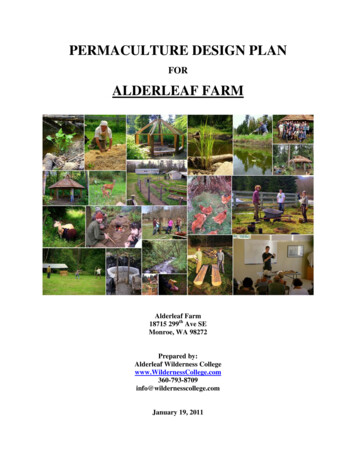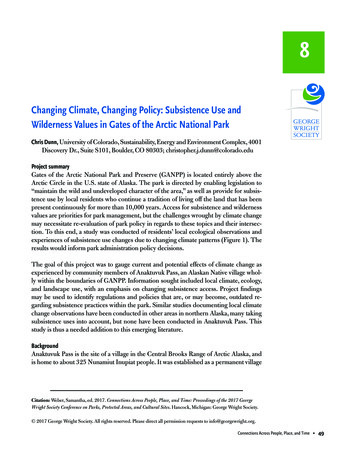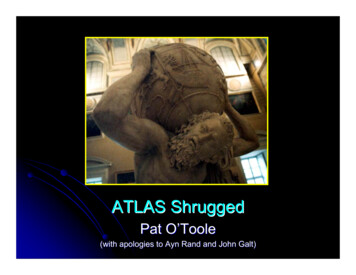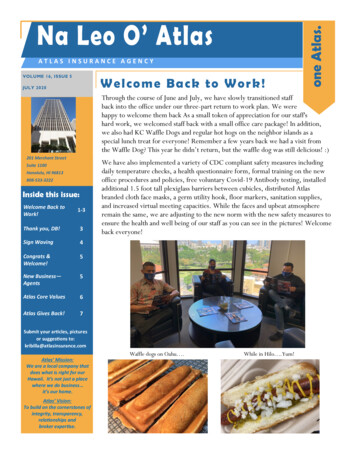
Transcription
Atlas ofBiodiversityAnPROTECTED LANDIN THECHICAGOWILDERNESSREGIONFederal Landsstate parkscounty preservesand city parksprivately ownEDnature areasFoxnature preservesand scientific areasD es P la inesDuPageLAKEMICHIGANLittle Calu metN0510MilesKankakee
Atlas ofBiodiversityAn
Chicago Wilderness, An Atlas of Biodiversity,is a publication of the Chicago Region Biodiversity Council.The members of the Council include:Brookfield ZooCanal Corridor AssociationChicago Academy of SciencesChicago Botanic GardenChicago Park DistrictCity of Chicago, Department of EnvironmentThe Field MuseumForest Preserve District of Cook CountyForest Preserve District of DuPage CountyForest Preserve District of Will CountyFriends of the Chicago RiverIllinois Department of Natural ResourcesIllinois Natural History SurveyIllinois Nature Preserves CommissionKane County Forest Preserve DistrictLake County Forest PreservesLake Michigan FederationLincoln Park ZooMcHenry County Conservation DistrictMetropolitan Water Reclamation District of Greater ChicagoMorton ArboretumThe Nature ConservancyNortheastern Illinois Planning CommissionOpenlands ProjectJohn G. Shedd AquariumSierra Club, Illinois ChapterUrban Resources PartnershipUS Army Corps of Engineers, Chicago DistrictUS Environmental Protection Agency, Region VUS EPA Great Lakes National Program OfficeUS Fish & Wildlife ServiceUSDA Forest ServiceUSDA Natural Resources Conservation ServiceUSDI National Park ServiceFunds for this publication were provided by:Illinois Conservation FoundationThe Nature Conservancy of IllinoisState of Illinois Department of Natural Resources, Conservation 2000 FundUSDA Forest Service Northeastern Area, State and Private ForestryUS EPA Great Lakes National Program OfficeWritten by Jerry SullivanDesigned by Corasue Nicholas
ContentsINTRODUCTION 5GEOLOGY OF THECHICAGO WILDERNESSREGION 6LIVING COMMUNITIES 13PRAIRIES 14Animals 20WOODED COMMUNITIESIntroduction 24Savannas 26Open Woodlands 27Flatwoods 28Forests 29Animals 30WETLANDSIntroduction 34Marshes and Shrub Swamps 36Sedge Meadows 37Fens 38Bogs 39Animals 40STILL WATERSLakes and Ponds 44MOVING WATERSStreams and Rivers 46THE DUNES 48LAKE MICHIGAN 49pe0ple on the landNative Americans 50Settlement 51The Creation of the Forest Preserves 54Restoration and Management 56APPENDICES AND INDEX 60
ENDANGERED AND THREATENEDSPECIES IN ILLINOISRARE AND ENDANGEREDNATURAL COMMUNITIES INCHICAGO WILDERNESSD es P lainesFoxLAKEMICHIGAN0-56-1516-2526-5051-100Over 100Little CalumetNKank a kee010MilesCritically imperiledGloballyimperiled Globally
Nature in theMetropolisThe Story of Chicago Wilder n e s sThe lands stretching south and west from theshores of Lake Michigan hold one of NorthAmerica’s great metropolises. Nearly eightmillion people live in northwestern Indiana, northeastern Illinois, and southeastern Wisconsin. Living amongthem, on islands of green, are thousands of nativespecies of plants and animals, species that make up someof the rarest natural communities on earth.We callthese communities and the lands and waters that aretheir homes Chicago Wilderness. Communities likethese—prairies, oak savannas, woodlands, marshes, fens,sedge meadows and others—once covered most of theMidwest.They have been destroyed almost everywhereto make way for towns and farms.Only small fragments survive, and many of the richestof these fragments are in Chicago Wilderness.The largestmetropolis in the region is also home to the finest surviving examples of the natural heritage of the Midwest.More than one-third of Illlinois’ dedicated nature preserves are in the six counties of Chicago Wilderness.The maps on the facing page suggest what is atstake.They show the concentration of rare animals andplants and the dense clusters of whole natural communities that may vanish from the face of the earth if theyare not protected in Chicago Wilderness.This Atlas provides an introduction to these endangered communities. It tells how they sustain themselvesand how natural forces—and people—have shaped themover thousands of years. It describes efforts to use landpreservation and ecological restoration to save them andtells where interested people can see them.A combination of enlightened action and historicalaccident has thus far prevented the extinction of thenatural wonders of Chicago Wilderness.They will survive into the next century only if we act to ensure thatsurvival.
6AN ATLAS OF BIODIVERSITYGEOLOGY of theCHICAGO WILDERNESSREGIONce built the landscape of the ChicagoWilderness. Major construction beganabout 26,000 years ago and ended about13,000 years ago when the glaciers recededfrom the Chicago region for the last time. Evenafter the ice had gone, the after effects ofglaciation repeatedly remade the shoreline ofLake Michigan.The lake stabilized at its presentsize just 2,000 years ago.The Ice Age, geologists call it the Pleistocene, saw four major ice advances in easternNorth America.The first occurred about500,000 years ago.The last—the Wisconsinstage—began about 70,000 years ago. At onetime, the Wisconsin ice spread as far asShelbyville, Illinois, 200 miles south ofChicago. Our landscape reveals the complexseries of ice movements that occurred duringthe later years of the Wisconsin glacial episode.The glaciers that covered our region were asmuch as a quarter of a mile thick. Land aroundthe northern Great Lakes is still rising, stillrebounding from the weight placed upon it bythe ice thousands of years ago.It would seem that something that bigcould go wherever it wanted to go, but in fact,the land under the ice exerted a powerfulinfluence on glacial movements. In centralNorth America, the ice followed river valleys,and over the course of the Pleistocene, scouredthose valleys into the deep, broad basins thatnow hold the Great Lakes.The landscape ofthe Chicago region records five major advancesof the ice out of the Lake Michigan basinalternating with periods when the ice retreatedto the basin.The glacial constructions cover a bedrockfoundation made of very old sedimentaryrocks. In the Chicago region, the most common type of bedrock is a magnesium-richIlimestone called dolomite that was originallydeposited on reefs set in shallow seas duringthe Silurian period about 400 million yearsago.The youngest bedrock in our region datesfrom the Pennsylvanian period about 300 million years ago.This is the rock that contains thecoal deposits in Will County.There are highlands and valleys in our bedrock, but none of them corresponds to thehighlands and valleys visible at the surface.Thesurface features are all made of material deposited by the glaciers or by the lakes thatappeared as the glaciers melted. In some places,these deposits are nearly 400 feet thick. Onlyalong the Des Plaines River in southwesternCook and western Will Counties are bedrockexposures large enough to have an effect onliving things.There, unique communities ofplants and animals live on soils only a fewinches thick that lie above the Silurian dolomite bedrock.GLACIAL DRIFTDrift is the traditional term for the material leftbehind by glaciers.There are two kinds of drift.Till is material that was deposited directly fromthe glacier. Outwash is material deposited bymeltwater flowing from the glacier.Glaciers are supreme earth movers. As theirenormous weight scrapes across the ground,they easily collect loose surface deposits.Bedrock is harder to dislodge, but they manageto collect it as well. Frozen into the ice as atotally unsorted mixture of giant boulders,cobbles, gravel, sand, silt, and the finest of clayparticles, drift can be carried hundreds of miles.When glaciers begin to melt, this materialdrops out and piles up in front of the ice.Glaciers are always moving, and sometimestheir rate of movement is equal to their rate of
Surface Depositsin theChicago WildernessRegionsoils formed underprairie grassesdark soils in glacial tilldark soils in glacial outwash6dark soils in beach depositsdark soils on bedrocksoils in lakebed deposits6soils in organic depositssoils formed under forestor savannalight soils in glacial tilllight soils in glacial outwashlight soils in loamy to sandylake depositsmoderately dark soils inlakebed IANADeposits left by the glaciers or by the lakes that formed as the glaciers melted are the raw materials of soils.Topography,drainage, climate, and vegetation shape these raw mateials into soils.The process takes centuries. In a dynamic landscape,vegetation may change more rapidly than soils.We may find prairies growing on forest soils and forests on prairie soils.Thescale of the map allows us to show only broad categories. Small patches of soil that do not match the surrounding land willnot appear.N
AN ATLAS OF BIODIVERSITY1mRichlandgravelA Geologic columnsubglacial(till)Crown PointWadsworth till)Lemont DriftWedron FormationLayers of glacial deposits 12 metersdeep show the history of one place inthe Chicago region. From the bottomup, sorted sands and gravels left bymeltwater flowing from a distant icefront.The ice movces closer. Unsorteddiamicton is mixed with sorted gravel.Ice covers the spot, dropping unsortedtill. Rapid melting drops materialfrom the top of the glacier. Finally, theice retreats and wind (eolian) scattersdust over the earlier ustrine,and gravityflowWoodstocksandproglacialfluvial6.5 m covered?LivingstonsiltGLACIAL PHASEcolumn widthindicates relativegrain ONMENTALINTERPRETATIONLand and Lakes SectionKeyclaysiltloamsandgravel8melting. Geologists call such times "still stands."The ice front appears to be standing still, but itis really acting like a giant conveyor carryingan endless supply of fresh drift to the ice front.At a stationary ice front, heaps of drift canform hills hundreds of feet high. Since thesehills are made of till, they are an unsorted mixture of everything from rocks the size ofgarages to microscopic clay particles. Immenseblocks of ice break off from the melting glacierand are buried in this debris. As they melt, theyform ponds and lakes.The landscapes created by these conditionsare called moraines. Moraines are places whereknobby hills and ridges are mixed with kettleholes where blocks of ice melted into lakes andmarshes.The Chicago region has hundreds ofsquare miles of moraines where the variedlandscape supports a rich assortment of naturalcommunities that are home to much of thebiodiversity of the Chicago wilderness.When a glacier a quarter of a mile thickbegins to melt, it floods the land with cascades,torrents, whole lakes full of water. In ourregion, many proglacial lakes were dammedbetween the ice front and older moraines.Theyfilled, endured for a few decades or a few centuries, and drained away. Rivers a mile widescoured valleys. In some places the water justpoured over the land in sheets.Water sorts the particles it carries. It takes aheavy, powerful flow to push a boulder along.As the current slows, smaller and smaller particles settle to the bottom: gravel, sand, and siltalong rivers; clays in the lake bottoms. Much ofthe surface deposits on the lowlands lyingbetween the moraines in the Chicago Wilderness are made of outwash.SHAPING THE LANDThe ice advance of 26,000 years ago that beganthe process of shaping our landscape broughtthe ice front to the Marengo Moraine, oftencalled the Marengo Ridge, which runs northand south through western McHenry Countyto Kane County.This is the westernmost andoldest of the moraines in our region.The push south to Shelbyville came afterthe building of the Marengo Ridge, but byabout 17,500 years ago, the ice front had onceagain melted back to the Chicago area.This wasthe beginning of a very eventful few thousandyears.The ice, in a complex dance of advanceretreat-readvance built a zone of overlappingmoraines that extends from western KaneCounty to the shore of Lake Michigan.The icemoved rapidly—by glacial standards—and eachepisode of moraine building was followed by aretreat when the ice melted back—often as faras the Lake Michigan Basin.The oldest moraines in our region are tothe west and south.The land gets progressivelyyounger toward Lake Michigan. Our largestmoraine belt is the Valparaiso Moraine whichruns south through Lake, Cook, and DuPageCounties before swinging east through WillCounty and Lake and Porter Counties in
GeologyGlacial ProcessesA glacier melts back from an endmoraine. The moraine acts as a dam,holding in the waters of a proglaciallake. The water cuts a single outletchannel through the moraine. As thelake drains away, the lake bottombecomes a plain marked with sandybeach ridges located along the LakeProglaciallakeIslandIcebergold lake bedKettlelakeEndMoraineMeltwater swirls down through ahole in the ice. The moving watercarries away smaller particles, leavinga mound of gravel called a kame.OldbeachridgeEndMoraineOld lakeoutletRiverterracesIceTillMeltwater flows under the ice in awinding channel like the meanderingcourse of a river. With the ice gone,deposits left by the water make anesker, a ridge that winds like a river.WaterIceTillThe narrow ridge of the Visitation Eskerin southwestern Cook County meandersthrough Cap Sauers’ Holdings, a CookCounty Forest Preserve.9
10AN ATLAS OF BIODIVERSITYWISCONSINGLENWOOD 14.5 – 12.2 kaILLINOISWISCONSINCALUMET 11.8 – 11.2 kaILLINOISOutletINDIANAWISCONSINCHIPPEWA 10.0 – 5.5 kaILLINOISINDIANAWISCONSINEARLY NIPISSING 4.5 – 4.0 kaILLINOISOutletINDIANAINDIANALake Michigan’s eventful historyThe lake began as a pro-glacial lake dammed between the icefront and the moraines that circle the southern end of the LakeMichigan Basin.This Glenwood Stage was 55 feet above thepresent level of the lake. Sand ridges on the moraines mark thatearly shore.The lake overtopped the moraine in what is nowsouthwestern Cook County and rapidly eroded an outlet (theSag Valley) nearly a mile wide.The Calumet Stage was about 35 feet above the presentlevel. Blue Island, where resistant bedrock had prevented erosionby the ice, stood above the water.The low-water Chippewa Stage occurred when a temporaryoutlet opened for Lakes Michigan and Huron through NorthBay, Ontario.Water fell to 300 feet below the present level. Forests grew in what is now deep water.Geologists call these early stages Lake Chicago.The title“Lake Michigan” refers to stages that occurred after ice hadcompletely left the basin.The Nipissing Phase of Lake Michigan saw water risingagain over the lake plain and drainage from the lake flowingsouth through the Sag and down the Des Plaines to the Illinois.This phase left several prominent landmarks, including thebeach ridge that provided the route for Clark Street in Chicago.
Geologybuilt up in undrained basins and blowing sandshave built the high dunes of the Indiana shore.SOILSThe deposits left by the glaciers and the lakestages are the raw materials of soils.The soilsthemselves develop over centuries, products ofclimate, topography, and the effects of livingthings.Soils that develop on hilltops are quite different from those that develop in low valleys—especially if the valleys are subject to regularflooding. Soils on steep slopes may erode as fastas they develop.Soils developed under forests are quite distinct from those that were created under prairies.Wetland soils are equally distinctive.We willdescribe these soils in more detail in the comingpages.PhysiographicDivisionsof theChicago WildernessRegionLake Plainmorainal sectionesDe s P lainFoxgrand prairieLAKEMICHIGANLittle CalumetN10keMilesnk a0KaIndiana.The Valparaiso Moraine is as much as25 miles wide with many high ridges and kettlehole lakes and marshes. Our youngestmoraines are the Lake Border Moraines inLake and northern Cook County, Illinois. Fiveseparate Lake Border moraines, all lying parallelto the shore of Lake Michigan, have beennamed.The low areas between these morainesare the valleys of the Des Plaines and ChicagoRivers. Glaciers never returned to land in theChicago region after the easternmost of thesemorainal ridges fell from the ice about 14,000years ago.However, the history of Lake Michigan wasjust beginning.The earliest proglacial lake, theGlenwood Phase of Lake Chicago, was 55 feetabove the present mean level of LakeMichigan. As the lake went up and down withthe geological changes that followed the retreatof the ice, it left behind beaches, sandspits, andthick layers of clay fallen from quiet waters.These features mark the largest of our lakeplains, the Chicago Lake Plain. Most of themodern city is located on this plain.The early stages of Lake Chicago drainedsouth to the Illinois and Mississippi Riversthrough a gap in the moraines called theChicago Outlet in what is now southwesternCook County.The rush of water through thisgap cut the Sag Valley and eroded the DesPlaines River channel down to bedrock inCook and Will Counties.After cutting the channel of the DesPlaines down to bedrock, the lake stabilized fora time, then dropped again after a new outletopened to the north, shutting down the socalled Chicago outlet. However, the lakereturned to the Chicago Outlet in later times,most recently during the Nipissing Phase ofLake Michigan, a period that ended only 4,000years ago.The youngest land in the region isalong the shore of Lake Michigan in northernLake County (IL).The land in Illinois BeachState Park is sand deposited by lake currentssince the end of the Nipissing Phase.Since the ice departed, the pace and scopeof change has drastically slowed. Deposits ofwind blown dust called loess (pronounced“luss.”) have accumulated on the glacial drift.Our rivers have cut more definite channels inthe intermorainal areas, although marshes, bogsand other wetlands show that much of the landis poorly drained or not drained at all. Peat haseChicago Wilderness is part of three separate physiographic regions. The regions differ in their geologicalhistory, their terrain, and their vegetation.11
12Pre-SettlementVEGETATIONOF THECHICAGO WILDERNESSREGIONThis map shows the vegetation of this regionbefore large-scale settlement changed it.Themap is uneven in quality. Detailed originalvegetation maps have been prepared forsome areas and only generalized maps (grassland vs. woodland) for others.The category“wooded communities” is used to describeareas where trees grew but where map makershave not specified what kinds of trees orhow densely they grew.The scale of the mapmakes it impossible to show small areas ofdistinctive vegetation.
PrairieSavannaWooded CommunitiesLIVINGCOMMUNITIESOak WoodlandUpland ForestTFloodplain Foresthe varied landscape that remained when the icedeparted and the lake retreated to its presentshoreline is the base that supports the biodiversityof the Chicago Wilderness. Sands and clays, hilltops and plainsoffer different opportunities to different plants and animals.Geology, topography, and climate combine with living thingsto create ecosystems.When we talk of a prairie ecosystem or aforest ecosystem we include both the living things and thenon-living things that have an effect on life.The term community or natural community refers just to theliving things in the ecosystem. Since plants respond more specifically to moisture and light, communities are usually describedor named by the vegetation.The members of a natural community are connected in many ways, and these connections are socomplicated that we will never understand all of them.We do know that the loss of a single species in a community can lead to the loss of more species. A flower disappearsbecause the insect that pollinated it is gone. Insects vanishbecause their food plants have died out.Healthy natural communities have room for all their species.In healthy communities, we see biodiversity. "Biodiversity"refers to the variety of life, from variations in the genes of individuals to the whole planet and all its millions of species. On aregional level, biodiversity can refer to the many communitiesthat exist side by side.Biodiversity helps natural communities survive catastrophes.Indeed for some species, events such as floods and storms areopportunities rather than catastrophes.In the Chicago Wilderness, we see biodiversity within communities and in the great variety of communities found in theregion.We have nearly a dozen wooded communities. Ourprairies are wet prairies, dry prairies, gravel hill prairies, andothers. Our wetlands are a very diverse collection of marshes,fens, sedge meadows, bogs, and swamps. Each of these separatetypes has its own special combination of animals and plants.The next section of this Atlas will introduce you to the natural communities of the Chicago Wilderness and describesome of the animals and plants that make their homes in thesecommunities.Dune ComplexWetlandsSwampBogLakesLAKEMICHIGAN05Miles10N
14AN ATLAS OF BIODIVERSITYPRAIRIESIn all my life, I never saw or dreamed of so beautiful a sight as the rolling prairies.Nothing can equal the surpassing beauty of the rounded swells and the sunnyhollows, the brilliant green of the grass, the numberless varieties and splendid hues ofmultitudes of flowers. I gazed in admiration too strong for words.Miss Bigelow's reaction was shared by manywho were lucky enough to see the tallgrassprairie in all its glory. She was a NewEnglander who had grown up among forests.There are prairies as far east as Massachusetts,but they are small, sunny islands in a sea oftrees. In the Illinois country, people movingwest found tall waving grasses and the "splendid hues" of wildflowers covering much of theland. Here the prairies were the sea, and thewoodlands were shady islands.The prairies ofIllinois were the first real American experienceof the wide-open spaces. Here you could findyourself in a prairie that stretched to the horizon, without a single tree in sight.Many early visitors expected the prairies tobe of little use to farmers.Their belief was thatany soil too poor to grow trees was too poorto grow crops. Others noted the advantages ofland that did not need to be cleared of trees.The prairie was instant pasture for cattle andhorses and needed only a plow to make itready to grow crops.However, the first settlers who tried turningprairie sod with the light wooden plows theyhad used in the forests got a rather nastyshock. A plow that would turn a clean furrowin forest soil skittered over the surface of theprairie sod like a pebble skipping across apond. Prairie soils seemed to be mostly roots.Breaking prairie sod became a business.Men traveled the settlements with heavy plowsEllen Bigelow1835pulled by several teams of oxen and hired outto plow land at so much an acre.The sound ofthe tearing roots, they said, was like the rattleof small arms fire, as if an infantry companywas engaged in battle. Individual farmerscouldn't plow the prairie until 1837 when anIllinois blacksmith named John Deere inventedthe steel moldboard plow.EVOLUTION OF THE PRAIRIEPrairies are grasslands.The dominant plants aregrasses—although many other kinds of plantsare present.The group of plants we call grassesevolved during the Miocene Epoch, a periodthat began about 25 million years ago. Grasseshave since become the dominant vegetationover large areas of the earth.The prairies ofNorth America, the pampas of South America,the steppes of Central Asia, and the plains ofEast Africa are all grasslands.Grasslands develop on flat lands in areaswhere long periods without rainfall are common—although the climate is not as dry as itis in deserts.These periods of drought may beregular seasonal occurrences—like the dry seasons of tropical lands—or they may happenonly in some years—like the summer droughtsof the American Midwest.Those periodic droughts and the flatground that offers few obstacles to advancingflames have made fire a major force in theecology of the world’s grasslands. Millions ofyears of evolution in the presence of fire have
Prairies15Historic Range of the PrairieLittle remains east of the Mississippi, but some of the biggest and best of thesurviving remnants are in the Chicago region.TallgrassMixed-grassBlazing star and goldenrod create a colorful display in a mid-summer prairie.The flower show starts in spring and continues until October.made the tallgrass prairie dependent on periodic fires for its survival.The prairies of central North America forma triangle extending from the foothills of theRockies on the west to Ohio on the east. In theChicago Wilderness, the prairies share the landwith a variety of wooded communities.To thewest, trees become more rare. On the highplains in the shadow of the Rocky Mountains,they grow only in narrow strips along the rivers.The western prairies—the grasslands of eastern Montana,Wyoming, and Colorado, areconsidered short-grass prairies. Precipitationaverages less than 20 inches a year. In the dry,windy environment, plants hug the ground, seldom growing much above a foot in height.With increasing precipitation, the grasses andShortgrassother prairie plants get taller. From centralNebraska east, tallgrass prairies dominate thetreeless parts of the landscape. Early accounts tellof grasses tall enough to hide a man on horseback.That height must have been rare, but settlers often lost cattle in the pastures of August.ROOTS AND SOILSMost of the biomass, the living material, of bothprairie grasses and prairie wildflowers—botanistscall them forbs—is underground. On deep soils,the root systems of some prairie species extendnearly 20 feet below the surface.They may livefor decades, each spring sending up new greenshoots to flower, set seed, and die.1 Side-oats grama grass, 2 Prairie dropseed, 3 Whorled milkweed, 4 Purple prairieclover, 5 Gray goldenrod, 6 False boneset,7Tall boneset, 8 Hoary vervain,9Cylindric blazingstar, 10 Daisy fleabane,11 Little13bluestem, 12 Indian grass,Rough blazingstar, 14 Round-headedbush-clover, 15 Stiff goldenrod, 16 Compassplant, 17 Big bluestem, 18 Wild quinine,19Rattlesnake master, 20 Culver’s root,21Wild onion, 22 Flowering spurge,23 Whitewild indigo, 24 Yellow-headedconeflower, 25 Canada goldenrod, 26 Prairiedock, 27 Switchgrass, 28 Obedient plant,29 NewEngland aster, 30 Saw-toothedsunflower, 31 Tall goldenrod, 32 Smoothwhite lettuce, 33 Mountain mint, 34 Canada7wild rye, 35 Stiff gentian, 36 Closed gentian,811637Fringed gentian,1739Blue flag iris,Cordgrass,Reddish bulrush,401210530 cattail 41Common6422733231152034191429244238Prairie blazingstar,2538911A prairie slope with plants of dryprairies at the top, mesic in the middle,wet at the foot of the slope.422313281841262235212933373640
16AN ATLAS OF BIODIVERSITYDr. Robert F. Betzof Northeastern Illinois University ledcampaign to save Indian BoundaryPrairies; initiated first large scale prairierestoration at Fermi National AcceleratorLab near Batavia, Illinois.Prairie remnants are scattered over theChicago region. Most of the prairies shownon this map are less than 20 acres.These huge root systems are constantlygrowing and constantly dying. New roots seeknew sources of minerals and water in the subsoil. Old roots die and decay, adding organicmatter to the soil.Organic matter may form a layer nearly twofeet thick in prairie soils. It is this organic matterthat gives prairie soils their dark color. Organicmatter also made prairie soils extremely productive of crops such as corn and soybeans.Thisfertility doomed nearly all the prairies.TYPES OF PRAIRIESAs many as 350 different species of plants grewon the prairies of Illinois, Indiana, and Wisconsin, but they didn’t all grow together. Insteadthey grew in distinctive communities. Eachcommunity had its own unique mix of species.Soil moisture and soil texture are the two mostimportant factors in controlling where thesecommunities grew. Prairies on wet soils sharedmany plants with such wetland communities assedge meadows and fens. Prairies on sandy soils,where the coarse soil texture lets water drainaway quickly after rains, often contained plantsmore common in the drier lands to the west.Ecologists have named five moisture groups:wet, wet-mesic, mesic, dry-mesic and dry.TheA line of life-giving fire blows across a prairie in the ChicagoWilderness. Fires are essential to the health of this ecosystem.word “mesic”—which means “in the middle”or “moderate”—turns up often in ecology. Inaddition, two kinds of prairies are classified bythe texture of the ground they grow in. Sandprairies grow along Lake Michigan and inlandas well. Gravel hill prairies often grow on topof kames.If we survey the plants growing in a wetprairie, we are likely to find that cordgrass(Spartina pectinata) and blue joint grass(Calamagrostis canadensis) are the most commongrasses. In dry prairies, side-oats grama(Bouteloua curtipendula) becomes important. Inmesic prairies, the dominant grasses are bigbluestem (Andropogon gerardii) and northerndropseed (Sporobolus heterolepis).The forbs showsimilar shifts.PRAIRIES AND FIREPrairiesin theChicagoWildernessLAKEMICHIGANN010MilesPrairies are fire-dependent communities.Without fire, tallgrass prairies are invaded bytrees and shrubs that kill the prairie plants withtheir shade.Without fire, species begin to vanish from the prairie. Smaller plants and plantswith small seeds seem to go first. Legumes alsodisappear.Their removal makes it easier forweeds to invade.Some trees can survive regular prairie fires.Bur oak (Quercus macrocarpa) and black oak(Quercus velutina) can live for a century ormore even though regular fires repeatedly killall parts of the plant that are above ground.They survive as roots—called “grubs.”Thegrubs are not harmed by the fires and eachyear, they produce new sprouts.When largescale settlement began, people noticed communities they called "brushy prairies." These
WILDERNESS REGION AnAtlasof Biodiversity. AnAtlasof Biodiversity. . survival. in the T. GEOLOGY of the CHICAGO WILDERNESS REGION GEOLOGY of the CHICAGO WILDERNESS REGION 6 AN ATLAS OF BIODIVERSITY I . moraine belt is the Valpara
